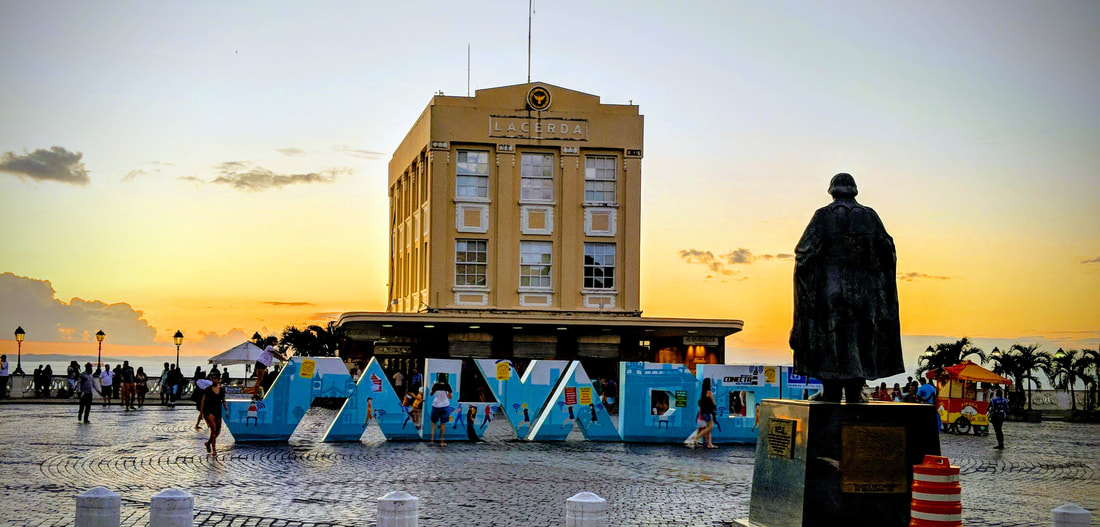|
By Grace Terlinden The biggest learning experience so far on the trip has been learning the influence that slavery had on Brazil. As Xavier Vatin mentioned in his lecture on, “The African Diaspora in Bahia: A Socio-Anthropological Perspective” there were over eight million slaves whom are thought to be brought to Brazil largely from Angola, Benin, Congo, and others (Brazil An Inconvenient Truth). All documentation of enslaved peoples were burned after abolition in 1888 which inhibits opportunities for Brazilians to connect with their African heritage, however the cultural influence from Africa cannot be dismissed or destroyed (Vatin 2022). The impact enslaved peoples had on Brazilian culture remains today through music, dance, and has implications on all aspects of Brazilian life, and still effects politics today. Music in Brazil still maintains many of it’s African characteristics and genres that were created by Africans. The lecture at the beginning of the percussion workshop with Mario Pam and Ilê Ahiê taught us that many of the musical genres that today Brazilians enjoy such as samba, jazz, and blues were all created by Africans. An outlet in which this musical influence shines through is during carnaval. Although carnaval started as a European tradition, but expanded into what it is today, because of black artists. An important aspect to carnaval is showcasing the Afro-Brazilian music styles such as Samba (Eakin 2017). The Afro-Brazilian influence of carnaval is not always appreciated, and has received backlash from the state. Marshall Eakin explained this struggle for representation and accreditation in his chapter Samba, Carnaval, and Getúlio Vargas and said, “The lower classes that created and sustained the escolas de samba began a long struggle with the representatives of the State as each attempted to control and determine the direction of carnaval with samba at its center” (2017). This quote probes that although African influence has made Brazilian music and carnaval what it is today, they are not always properly acknowledged for their success. As seen with carnaval, music is often accompanied with dance, and in the case of Brazil, dance is also heavily influenced by the enslaved people. Some of the most popular forms of dance in Brazil were either created or heavily influenced by enslaved peoples. Capoeira was created by slaves in order to defend themselves from their oppressors, but presently it is less about self-defense and more of a dance. In our workshop with Mestre Sapoti, he explained that today Capoeira is used to remember the atrocities of slavery and to keep pushing towards racial equality (2022). It is a common misconception that enslaved peoples were not pushing back against oppression, but amidst the tyranny, Capoeira is proof that all along enslaved people were constantly fighting back. Gladys Mitchell-Walthour stated in their book The Politics of Blackness: Racial Identity and Political Behavior in Contemporary Brazil, “Running away and revolts were forms of resistance. There were a number of revolts led by enslaved people” (2017). Afro-Brazilians created many forms of art such as dance and music as a form of resistance, and in the case of Capoeira as a revolt against slave owners. Not only did Afro-Brazilians create a lot of the music and dance enjoyed today in Brazil, but they did it in spite of the violence their oppressors held over their heads. The influence of slavery in Brazil has sparked my interest since being here, because although slavery is often thought to have happened a long long time ago and some consider it’s impacts to no longer exist. It didn’t really hit me how little time has passed since slaveries abolition until taking to our tour guide Fredi who showed me a picture of his father-in-law whose father was a slave. This interaction was important to my understanding about the individual as well as collective impacts that slavery still has on Brazil and internationally. Slavery’s influence on Brazilian culture is certainly important, but the individual impacts it still has today should be acknowledged. The “color-blind” ideology that has been popularized in Brazil as a form of complete racial equality is therefore the quite opposite of equal. Without acknowledging the cultural and social implications that the legacy of slavery has on Brazil will only exacerbate racial inequality. Raising awareness and giving credit to Afro-Brazilians who have made positive influences on music, dance, and culture is also an important step towards repairing racial inequalities. Works Cited: Brazil An Inconvenient Truth : BBC Documentary. 2020. Video. Eakin, Marshall C. 2017. «Communicating and Understanding Mestiçagem: Radio, Samba, and Carnaval». Chapter in . Becoming Brazilians: Race and National Identity in Twentieth- Century Brazil, 79–106. New Approaches to the Americas. Cambridge: Cambridge University Press. doi:10.1017/9781316800058.004. Eakin, Marshall C. 2017. «The Sounds of Cultural Citizenship». Chapter in . Becoming Brazilians: Race and National Identity in Twentieth-Century Brazil, 200–219. New Approaches to the Americas. Cambridge: Cambridge University Press. doi:10.1017/9781316800058.008. Mitchell-Walthour, Gladys L. 2017. The Politics of Blackness: Racial Identity and Political Behavior in Contemporary Brazil. Cambridge Studies in Stratification Economics: Economics and Social Identity. Cambridge: Cambridge University Press. doi:10.1017/9781316888742.  Grace Terlinden is a rising senior at the College of Saint Benedict/Saint John’s University, pursing degrees in English and Political Science. She is originally from Big Lake, Minnesota. She enjoys learning about international relations through her involvement in Model United Nations. She is very excited to learn more about Brazilian politics and life in Brazil while studying abroad.
0 Comments
Leave a Reply. |
Archives
June 2024
Categories
All
|

 RSS Feed
RSS Feed
